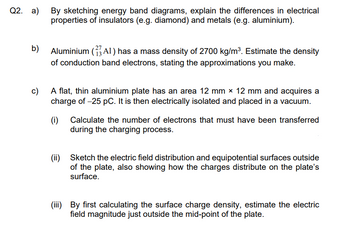Question
Q2 part c

Transcribed Image Text:Q2. a)
b)
By sketching energy band diagrams, explain the differences in electrical
properties of insulators (e.g. diamond) and metals (e.g. aluminium).
Aluminium (AI) has a mass density of 2700 kg/m³. Estimate the density
of conduction band electrons, stating the approximations you make.
c)
A flat, thin aluminium plate has an area 12 mm × 12 mm and acquires a
charge of -25 pC. It is then electrically isolated and placed in a vacuum.
(i) Calculate the number of electrons that must have been transferred
during the charging process.
(ii) Sketch the electric field distribution and equipotential surfaces outside
of the plate, also showing how the charges distribute on the plate's
surface.
(iii) By first calculating the surface charge density, estimate the electric
field magnitude just outside the mid-point of the plate.
Expert Solution
This question has been solved!
Explore an expertly crafted, step-by-step solution for a thorough understanding of key concepts.
Step by stepSolved in 2 steps with 2 images

Knowledge Booster
Similar questions
- Problem 015arrow_forwardA new car is tested on a 270-m-diameter track. Part A If the car speeds up at a steady 1.2 m/s², how long after starting is the magnitude of its centripetal acceleration equal to the tangential acceleration? Express your answer with the appropriate units. At = Submit μÅ Value Request Answer Unitsarrow_forwardQ6 Please provide justified answer asaparrow_forward
arrow_back_ios
arrow_forward_ios